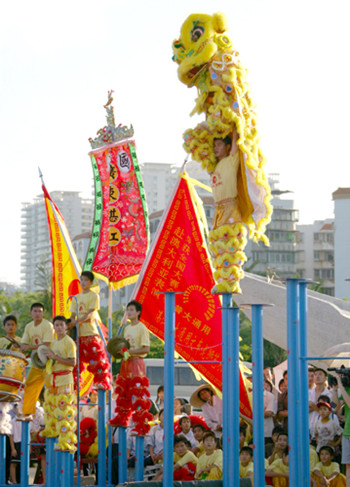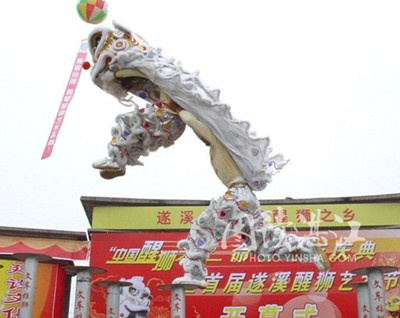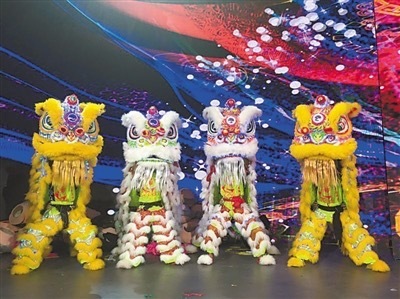Home> Folk Art Types
Suixi, home of Zhanjiang lion dance
Updated: 2017-03-08
The lion dance has a long history, especially in Zhanjiang, a city in Guangdong province in South China.
This traditional masked dance expresses the lion's courage and superiority and is performed to chase away evil spirits and monsters. It has been performed during the Chinese New Year and other festivals or special celebrations since ancient times. Lion dances are still very popular across the country.
In the dance, teams of men wear lion costumes and imitate the animal's fast and energetic movements and gestures to the loud beat of drums.
 |
|
The Suixi lion dance, also known as the waking lion dance, is performed on poles during festivals in Zhanjiang, Guangdong province. [Photo/gdsqyg.com] |
Usually involving two performers for each lion — one at the head and the other at the tail — the dance requires perfect coordination and mastery of difficult acrobatic skills.
The man at the front controls the lion's head by moving its eyelids to create constant expressions, which produce a vivid image of a lion. While he does this he has to also concentrate on his foot movements to ensure good cooperation with his colleague at the back of the lion. The swaying of the tail requires energetic movements to sweep away bad luck from the past.
The aesthetic power of each fundamental dance movement such as kicks, leaps and sudden turns can be found in Chinese martial arts, while the musical rhythm of drums, cymbals and gongs adds to the power of the spectacle.
The dance has two main forms. The first originates from North China. The second comes from the South, especially in the Lingnan areas of Guangdong. The latter features exaggerated movements and very colorful appearance.
 |
|
The well-known Longwan Dragon & Lion Dance Troupe comes from Suixi county. [Photo/Zhanjiang.gov.cn] |
Zhanjiang's version of the lion dance, which was introduced during the Ming and Qing dynasties (1368-1911), is the typical Southern Lion. The city's Suixi county is famous for the exquisite performance skills of its people, whose style is also called "the waking lion dance".
The county was dubbed the Hometown of Chinese Waking Lions by the China Society for the Study of Folk Literature because of its total industry chain from costumes manufacturing to sales to performance.
Suixi's waking lion dance has been a favorite art form with the public for over 20 years, according to locals. "Some of us take it as a hobby and a good way to exercise," said one villager.
 |
|
The well-known Longwan Dragon & Lion Dance Troupe comes from Suixi county. [Photo/Zhanjiang.gov.cn] |
By the end of 2015, the county had 255 lion dance teams involving more than 10,000 people, including men and women. Their performances come typed in two categories based on whether they are performed on the ground. The most distinct one has the lions doing difficult maneuvers while walking and jumping on tall poles, with the highest up to 3 meters, and the other is performed on the ground with dynamic acrobatics.
One of the best local teams is the Longwan Dragon & Lion Dance Troupe, who have won various prizes at national competitions and made frequent appearances at major stages in countries such as South Korea.
Zhanjiang opened a lion dance museum in 2015 to preserve and promote the state-approved cultural heritage.
